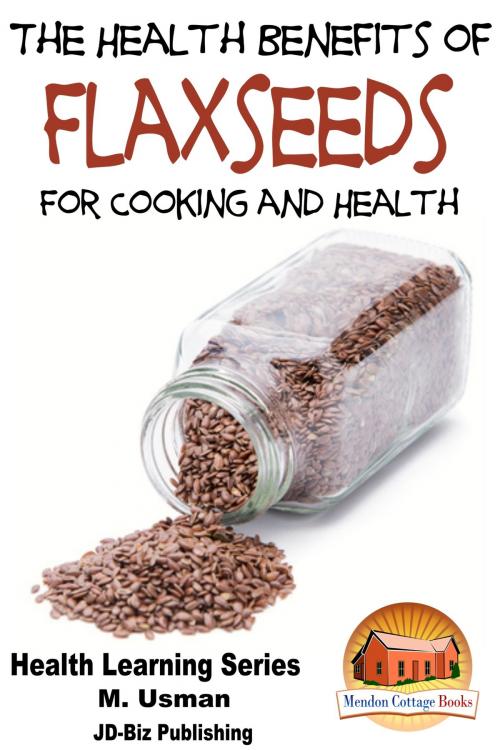| Author: | M. Usman | ISBN: | 9781311287854 |
| Publisher: | Mendon Cottage Books | Publication: | November 1, 2015 |
| Imprint: | Smashwords Edition | Language: | English |
| Author: | M. Usman |
| ISBN: | 9781311287854 |
| Publisher: | Mendon Cottage Books |
| Publication: | November 1, 2015 |
| Imprint: | Smashwords Edition |
| Language: | English |
Health Benefits of Flaxseeds For Cooking and Health
Table of Contents
Getting Started
Chapter # 1: Intro
Chapter # 2: Nutritional Worth
Chapter # 3: Selection and Storage
Chapter # 4: Precautions
Big Fiber Load:
Oxidation/Rancidity:
Cyanide:
Flaxseed Oil, an alternative to Fish Oil?
Health Benefits of Flaxseeds
Chapter # 1: Introduction
Chapter # 2: The Uniqueness of the Nutrients
Chapter # 3: Cardiovascular Benefits
Chapter # 4: Cancer Prevention
Chapter # 5: Radio-protector
Chapter # 6: Reduction in hot flashes
Conclusion
References
Getting Started
Chapter # 1: Intro
In this day and age, if it was said that flaxseed is the most underrated, natural product in terms of nutrition; the statement wouldn’t be wrong. A very little percentage of people in the civilized world know about the existence of flaxseed, let alone about its wonders. And even those who can identify it call it by a different name, i.e. the ‘linseed’. Comprehensively speaking, flaxseeds are seeds acquired from the fruit of the flax plant. The seeds are of glossy brown appearance, although the color may vary according to the type and resemble the seeds of a watermelon in shape. The plant is one of the easiest cultivated crops and can be found in both tropical and subtropical environments.
There is no need to open encyclopedias to learn about the wonders of flax; its importance in our everyday life can be established simply by breaking down and studying its scientific name, Linum usitatissimum. The linum part of the name sounds much like the fabric linen and it is by no coincidence that the fabric is a product of the flax plant. The second part of the word when translated from Latin means, “of greatest use”, and it is true that flax has fulfilled that promise by not only supplying people with a sustainable food source but also by products that can be used to manufacture goods ranging from sails, bow strings and even body armor.
The history of flaxseeds began somewhere between 4000BC and 2000BC when the cultivation of flax became a common practice in and around the Middle East& Mediterranean. Since its very inception, the culinary and domestic worth of flaxseeds have run in parallel with each other. Nowadays, flaxseeds are divided according to their quality with the highest one being used for cooking purposes and medium/low quality flaxseeds being processed and then being used in wood finishes, coatings, paints and industrial chemicals.
The two most basic varieties of flaxseeds include brown flaxseeds and yellow/golden flaxseeds, both being identical in terms of health benefits with only one exception separating them. Scientists have discovered that a component of the yellow flaxseeds called, ‘solin’ has made the yellow flaxseeds more appropriate for the production of culinary products such as oils. And although brown flaxseeds are also used for the production of cooking oils, most of them find their way in cattle feed, fiber and chemical factories.
Health Benefits of Flaxseeds For Cooking and Health
Table of Contents
Getting Started
Chapter # 1: Intro
Chapter # 2: Nutritional Worth
Chapter # 3: Selection and Storage
Chapter # 4: Precautions
Big Fiber Load:
Oxidation/Rancidity:
Cyanide:
Flaxseed Oil, an alternative to Fish Oil?
Health Benefits of Flaxseeds
Chapter # 1: Introduction
Chapter # 2: The Uniqueness of the Nutrients
Chapter # 3: Cardiovascular Benefits
Chapter # 4: Cancer Prevention
Chapter # 5: Radio-protector
Chapter # 6: Reduction in hot flashes
Conclusion
References
Getting Started
Chapter # 1: Intro
In this day and age, if it was said that flaxseed is the most underrated, natural product in terms of nutrition; the statement wouldn’t be wrong. A very little percentage of people in the civilized world know about the existence of flaxseed, let alone about its wonders. And even those who can identify it call it by a different name, i.e. the ‘linseed’. Comprehensively speaking, flaxseeds are seeds acquired from the fruit of the flax plant. The seeds are of glossy brown appearance, although the color may vary according to the type and resemble the seeds of a watermelon in shape. The plant is one of the easiest cultivated crops and can be found in both tropical and subtropical environments.
There is no need to open encyclopedias to learn about the wonders of flax; its importance in our everyday life can be established simply by breaking down and studying its scientific name, Linum usitatissimum. The linum part of the name sounds much like the fabric linen and it is by no coincidence that the fabric is a product of the flax plant. The second part of the word when translated from Latin means, “of greatest use”, and it is true that flax has fulfilled that promise by not only supplying people with a sustainable food source but also by products that can be used to manufacture goods ranging from sails, bow strings and even body armor.
The history of flaxseeds began somewhere between 4000BC and 2000BC when the cultivation of flax became a common practice in and around the Middle East& Mediterranean. Since its very inception, the culinary and domestic worth of flaxseeds have run in parallel with each other. Nowadays, flaxseeds are divided according to their quality with the highest one being used for cooking purposes and medium/low quality flaxseeds being processed and then being used in wood finishes, coatings, paints and industrial chemicals.
The two most basic varieties of flaxseeds include brown flaxseeds and yellow/golden flaxseeds, both being identical in terms of health benefits with only one exception separating them. Scientists have discovered that a component of the yellow flaxseeds called, ‘solin’ has made the yellow flaxseeds more appropriate for the production of culinary products such as oils. And although brown flaxseeds are also used for the production of cooking oils, most of them find their way in cattle feed, fiber and chemical factories.















